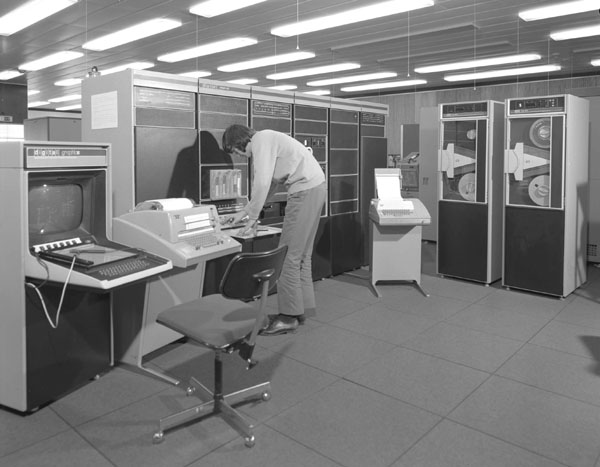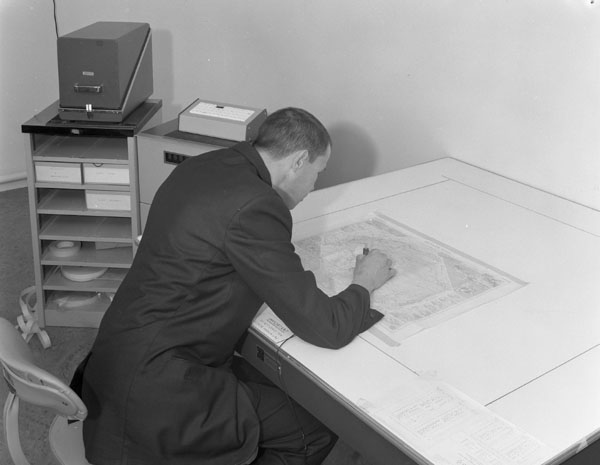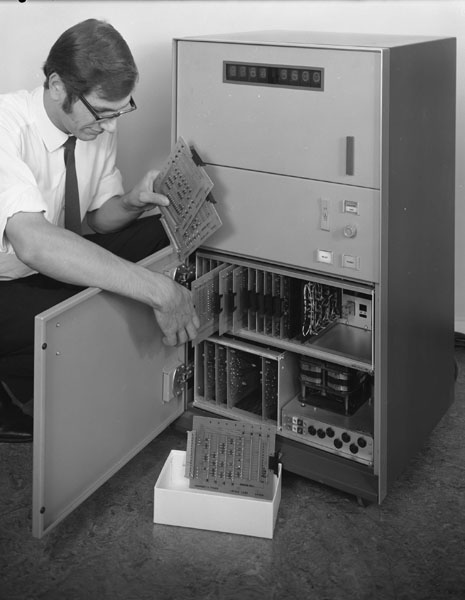

The PDP15 arrived in October 1970, about a month late. The VT15 display, however did not arrive with the PDP15. DEC had had a number of problems with the development of the 50 cycle version of the display. Atlas were lucky in that the first UK VT15 had gone to READAC for VLSI design work and they uncovered a number of faults that were checked out on the Atlas system in the factory.
The lateness of the display's arrival did mean that there was more time early on to get familiar with the basic software on the system. The plan early on was to develop a set of stand-alone applications to explore the capabilities before defining a unified system (later called PIGS: PDP15 Interactive Graphics System) to connect the PDP15 and 1906A. There was no immediate hurry to develop this as the hardware development of the fast BSI Link to the 1906A was due for completion until the last quarter of 1971.
The PDP15 system had no lineprinter, so early on Paul Nelson produced a utility that allowed files to be dumped on to the 7-track magnetic tape deck for printing on Atlas. Some of the problems encountered were:
By the end of 1970, a fairly reliable print system had been developed.
A copy of VTPRIM, the VT15 display software package had arrived, despite having no display. Bob Hopgood modified this so that instead of producing display files to be executed on the VT15, the execution part was inhibited and the display file printed. This allowed a certain amount of program debugging to be carried out. A program was also written by Bob Hopgood to take the display file and generate the equivalent graphical image on the SC4020. It was useful as a debug aid and proved useful long term as a screen capture mechanism.
One concern was the quality of the code produced by the Fortran compiler. Would it be good enough to develop all the software in Fortran, or would assembly language coding be needed. Graham England did a lot of analysis of the code quality while the display was awaited.

Julian Gallop took on the task of writing the SC4020 emulator and was able to get most of the of the tape reading side completed before the display arrived.
The photograph above is soon after the PDP15 had been moved into the 1906A machine room. The VT15 display is in the foreground.
As an exercise, the simple SCFOR graphics package on the Atlas that generated SC4020 output, was moved to the PDP15 mainly to give a view of the relative speeds of the Atlas and PDP15.
The basic operating (monitoring) system of the PDP15 allowed one program to run in the foreground and a second in the background. (That is the reason for the second teletype near the tape decks.) The hope was that one person could be developing software while another was using the interactive display. It soon became clear that the initial memory of 16K 18-bit words was insufficient for that is be possible and would need to wait until a memory upgrade was made. Most of this analysis was done by Graham England.
The DMAC pencil follower was interfaced to the PDP15 by Paul Nelson and Graham England.


The DMAC provided a digitising service for many users, not all doing computer graphics.
Paul Nelson developed an animation system called DOOM (DMAC Output Onto Microfilm) which allowed non programmers to produce animation just using the DMAC.
The central area of the DMAC was for drawing and around it were nine areas that defined commands:
|
SAVE |
ADVANCE FILM |
STORE |
|---|---|---|
|
THICKEN |
PICTURE AREA |
NEWLINE |
|
SPATH |
FINISH (RESTART) |
TAKE |
The user was able to draw simple paths and save backgrounds. Only moving objects needed to be redigitised. The digitisation could eventually be viewed on the VT15. The user could specify a path along which the object would move. Eventually the DMAC keyboard could be used to input both text and simple commands so that standard shapes such as squares and circles could be generated by a few points input on the DMAC.